Marietta, Georgia – On May 1st & 2nd Flightline Aviation Media joined a select group of twitter users for a unique tour of Lockheed-Martin’s Marietta, Georgia factory and for the delivery ceremony of the final F-22 Raptor to the U.S. Air Force. This was a special opportunity to get a first-hand look at the production processes L-M uses in the production of military aircraft.
This plant, which is as big as 4 Super WalMarts and has 800 workers, has been a fixture in the city of Marietta since World War 2. The C-141 Starlifter, C-5 Galaxy, and the F-22 were built here but probably the most well known and longest running product of this factory is the C-130 Hercules, which has been in production since the late 1950s and currently has over 200 units on order. With a production rate of 36 per year, there will be new aircraft rolling out of this line for years to come. Part of this is, of course, testament to the versatility of the C-130 and the many different roles its variants can be adapted to.
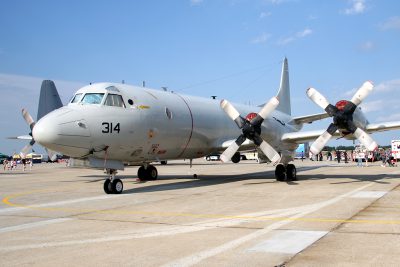

There are 3 main areas of the production floor. The first is devoted to L-M’s Mid-Life Upgrade Program for the P-3 Orion. This 4-engine turboprop plane (shown above, left) was introduced in 1962 and is used by the Navy for anti-submarine and maritime surveillance. With 50 years of use in corrosive environments, the plane’s structure will need to be upgraded or else they’ll eventually have to be scrapped. This program will add about 20 years to the service life of the aircraft and is accomplished by replacing the wings and horizontal stabilizer with new parts. The wings and related parts are built here at Marietta and delivered to the contractor who will install it on the aircraft. Our tour showed us the process involved in building a pair of wings and the internal structure (shown above, right).
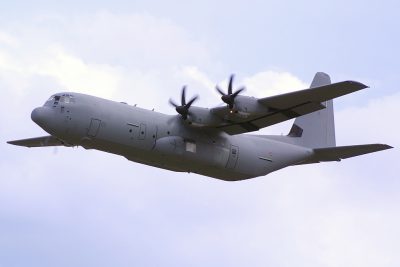
The largest area of the plant is for production of the C-130J and variants used by the U.S. Marines for aerial refueling and Special Ops. The entire aircraft is built here in sections – nose, forward fuselage, tail section, wing box – and then the pieces are mated on an assembly line. The vertical & horizontal stabilizers on the tail are added, followed by the wings. The engine cores come in metal crates labeled “Rolls-Royce” and are brought into the Engine Shop where workers build them up by hand. They’re then rolled over to the line and hoisted into place. The Engine Shop is a special fenced-off area because it is a FOD Critical Zone. What this means is workers who enter must take special precautions to eliminate foreign object debris (FOD) which can cause damage or be deadly if it gets into an engine. There are posters up all over the factory reminding workers of the dangers of FOD. Quality control is everywhere here; the goal is 100% first-time quality, which means every single aircraft must be 100% perfect the first time it is operated. Once on the main assembly line, the parts and sections begin to come together to resemble an airplane. The plane moves forward to the next station on the line about every week. Once the structure is complete, there are interior and avionics installation stations. The final stations perform tests of the hydraulic systems and inspections. After construction, the brown colored aircraft is taken to a special paint hangar in another part of this facility to receive its traditional military-grey paint – except the ones purchased by the arab state of Oman which get a desert camo tan color scheme. We were given a tour of the flight line where the finished planes await their new owners – there were C-130s for Canada, Oman, and a few for the U.S. including an MC-130 for the Marines.

Discussing the C-130 production process with Operations Director Mike Fox
Photo ©Lockheed-Martin
The third product built at this plant is the center wing box for Lockheed’s F-35 Joint Strike Fighter. This part is one of the most critical parts of the structure. The wing box supports the wings and the center of the fuselage. The plane itself is assembled at L-M’s factory in Fort Worth, Texas.
On Wednesday, we were witness to the ceremony that officially transferred the last production F-22 to the U.S. Air Force. It is to be part of the 525th Fighter Squadron and based at Joint Base Elmendorf in Anchorage, Alaska.
The F-22 Raptor program began in 1991 and the first aircraft was completed in 1997. The first production unit was completed in 2003, and the Raptor became operational in the U.S. Air Force in 2005. A total of 187 units were built ending with serial number 4195 in December 2011 (plus 8 test planes) at a total cost of $412 million each with upgrades, research, and development factored in. This plane is the world’s only 5th generation fighter jet capable of air dominance with stealth, ground attack, and electronic warfare capabilities. There has been some recent concern over problems with the pilot’s oxygen supply system but Lockheed-Martin plans continuous upgrades and refinement to the fleet.
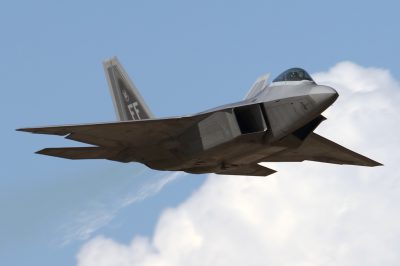
An F-22 Raptor performing a high speed pass at an air show

The F-22’s bombs and missiles are carried internally
to increase its stealth capability.
“The very existence of this airplane, your airplane, has altered the strategic landscape forever.”
Several Lockheed-Martin officials as well as Georgia’s Sen. Isackson and Air Force Chief of Staff Gen. Norton Schwartz gave remarks in a 45 minute ceremony. L-M’s VP in charge of the F-22 program Jeff Babione then presented the ceremonial key to Gen. Schwartz, who then handed it over to 525 FS commander Lt. Col. Paul “Max” Moga and his crew chief, Staff Sgt. Damon Crawford. Afterward, it was time to open the doors and reveal the new jet parked outside, and of course a photo opportunity!
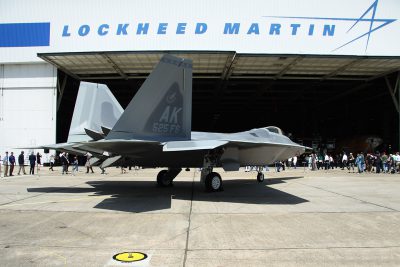
Lockheed-Martin F-22 Raptor # 10-4195

Lockheed-Martin F-22 Raptor # 10-4195
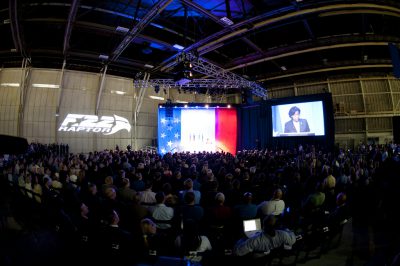
Lockheed-Martin F-22A raptor #4195 Delivery Ceremony
Photo ©Lockheed-Martin

Presentation of the key to Gen. Schwartz

Leave A Comment